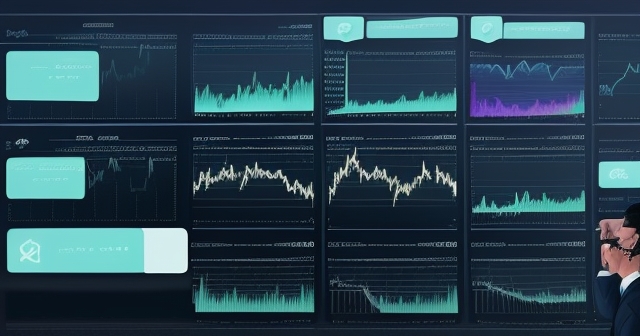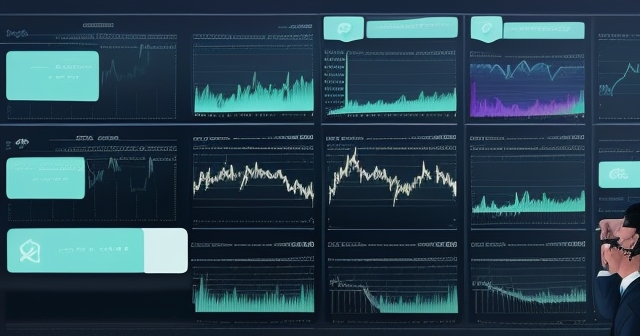
Forex Rollover: Understanding Its Impact on Your Overnight Trades
Table of Contents
ToggleUnderstanding Forex Rollover: The Invisible Force Shaping Your Overnight Trades
Have you ever held a forex position open overnight? If so, you’ve likely encountered the concept of forex rollover, also known as a swap rate or financing charge. Far from being a hidden fee, rollover is a fundamental aspect of currency trading, acting as either an earning or a cost that directly impacts your profitability when positions extend beyond a single trading day. For both novice investors just starting to navigate the markets and experienced traders looking to refine their strategies, a deep understanding of rollover is not just beneficial—it’s essential for effective cost management and potentially uncovering unique trading opportunities.
Think of it like the interest you pay or earn on an overnight loan. When you trade currencies, you’re essentially borrowing one currency to buy another. Holding this ‘loan’ overnight requires an adjustment based on the interest rates of the two currencies involved. This is where rollover comes in. It reflects the net interest rate difference between the two currencies in a pair for holding the position from one trading day to the next. Ignoring this crucial element can significantly erode profits or unnecessarily inflate costs on positions held for more than a few hours.
- Forex rollover can be seen as a financing cost for holding positions overnight.
- The rollover rate is determined by the interest rate differential between the two currencies in the pair.
- Rollover can either be a credit or debit depending on your position’s interest rates.

Why Rollover Exists: The Mechanics of Settlement
To truly grasp rollover, we need to understand the underlying process of currency settlement in the spot forex market. When you execute a standard spot forex trade, the agreement is for the exchange of currencies to be settled two business days after the trade date (this is often referred to as the T+2 settlement cycle). For example, if you buy EUR/USD on a Monday, the actual exchange of euros for dollars is technically scheduled to occur on Wednesday.
However, most retail forex traders never intend to take physical delivery of billions of units of currency. We are trading on the price difference, speculating on the exchange rate movement. When you keep a position open past the daily market close (specifically, the time when brokers process rollovers, typically 5:00 PM ET), you are effectively requesting that the settlement date for your trade be postponed by one day.
Brokers manage this by what is sometimes described as ‘rolling’ the position forward. Conceptually, they close the existing position based on the current day’s value date and simultaneously reopen it for the next day’s value date. This process of extending the settlement date incurs an interest adjustment, which is the forex rollover. It compensates for the interest rate differential between the two currencies over that one-day extension period. Because you are theoretically borrowing one currency and holding another, the broker adjusts your account to reflect the net interest cost or earning based on the interest rates associated with those currencies for that period.

The Core Driver: Understanding Interest Rate Differentials
At the heart of the forex rollover calculation lies the interest rate differential. Each country’s central bank sets a benchmark interest rate for its currency. This rate influences borrowing and lending costs within that economy. When you trade a currency pair, say EUR/USD, you are dealing with two distinct interest rates: the rate set by the European Central Bank (ECB) for the Euro and the rate set by the Federal Reserve (Fed funds rate) for the US Dollar.
The difference between these two interest rates is the interest rate differential. If the interest rate for the Euro is higher than the interest rate for the US Dollar, there is a positive differential when holding Euros and borrowing Dollars. Conversely, if the US Dollar rate is higher, there is a positive differential when holding Dollars and borrowing Euros.
| Scenario | Interest Rate Differential |
|---|---|
| Euro > Dollar | Positive |
| Dollar > Euro | Negative |
This differential is the primary factor determining whether you receive a rollover credit (you earn interest) or pay a rollover debit (you pay interest) on your position. It’s a direct consequence of the economic principle that holding a higher-yielding asset while borrowing a lower-yielding asset should, in theory, generate a net interest gain, and vice versa.

Central banks adjust these interest rates based on their monetary policy goals, such as controlling inflation, stimulating economic growth, or managing exchange rates. These adjustments can change the interest rate differential and, consequently, the swap rates applied to currency pairs. Therefore, staying aware of central bank announcements and economic calendars is crucial for anticipating changes in rollover costs or earnings, especially for long-term trading strategies or carry trades.
Credit vs. Debit: How Your Position Matters
Whether you receive a rollover credit or incur a rollover debit depends entirely on two factors: the interest rate differential between the currency pair and whether your position is long (you bought the pair) or short (you sold the pair).
Let’s break it down using a hypothetical currency pair, Currency A / Currency B:
-
Scenario 1: Currency A has a HIGHER interest rate than Currency B.
- If you are LONG Currency A / Currency B (meaning you bought Currency A and implicitly borrowed Currency B), you are holding the currency with the higher interest rate (Currency A) and borrowing the currency with the lower interest rate (Currency B). In this case, you will likely receive a rollover credit. You are earning more on the currency you hold than you are paying on the currency you borrowed.
- If you are SHORT Currency A / Currency B (meaning you sold Currency A and implicitly borrowed Currency A to buy Currency B), you are holding the currency with the lower interest rate (Currency B) and borrowing the currency with the higher interest rate (Currency A). In this case, you will likely pay a rollover debit. You are paying more on the currency you borrowed than you are earning on the currency you hold.
-
Scenario 2: Currency A has a LOWER interest rate than Currency B.
- If you are LONG Currency A / Currency B, you are holding the lower-yielding currency (Currency A) and borrowing the higher-yielding currency (Currency B). You will likely pay a rollover debit.
- If you are SHORT Currency A / Currency B, you are holding the higher-yielding currency (Currency B) and borrowing the lower-yielding currency (Currency A). You will likely receive a rollover credit.
It’s crucial to remember that your broker will display separate swap rates for long positions and short positions for each currency pair. These rates are typically quoted in pips or as a monetary value per standard lot. They also often include a small adjustment or markup applied by the broker, meaning the actual swap rates you see on your platform might differ slightly from the pure interest rate differential between the central bank rates.

How Rollover is Calculated: Formula and Factors
While your trading platform automatically calculates and applies the forex rollover to your account, understanding the basic principle behind the calculation can provide valuable insight into how it impacts your trades. The precise formula used by brokers can vary slightly, but the core components are always the same:
-
The Interest Rate Differential: As discussed, this is the difference between the annualized interest rates of the two currencies in the pair.
-
The Notional Amount of the Trade: This refers to the total value of the currency being traded. For example, one standard lot is typically 100,000 units of the base currency.
-
The Current Exchange Rate: This is needed to convert the interest amount (calculated in the base currency) into your account currency (e.g., USD, EUR).
-
The Number of Days: Typically, rollover is calculated for one day, except on the day the triple swap is applied.
| Factors | Description |
|---|---|
| Interest Rate Differential | Difference between two currencies’ interest rates |
| Notional Amount | Total value of currencies being traded |
| Exchange Rate | Current exchange rate of the currency pair |
| Number of Days | Number of days for which rollover is calculated |
A simplified conceptual formula might look something like this (for a long position, for example):
Rollover Amount = (Notional Amount * (Interest Rate of Base Currency - Interest Rate of Quote Currency) / 365) * Exchange Rate (Quote/Account Currency)
Let’s say you are long 1 standard lot (100,000 units) of AUD/JPY. Assume the Reserve Bank of Australia (RBA) rate is 3.10% and the Bank of Japan (BOJ) rate is 0.10%. The interest rate differential is 3.00%. Let’s also assume the AUD/JPY exchange rate is currently 90.00 and your account currency is USD (and the USD/JPY rate is 130.00).
The calculation would roughly involve:
- Calculating the daily interest differential in JPY (100,000 AUD is worth 9,000,000 JPY).
- Interest differential per year in JPY = 9,000,000 JPY * 3.00% = 270,000 JPY.
- Interest differential per day in JPY = 270,000 JPY / 365 ≈ 739.73 JPY.
- Converting to USD (if your account is in USD) = 739.73 JPY / 130.00 (USD/JPY) ≈ 5.69 USD.
So, you might expect to receive around $5.69 in rollover credit per day for holding this position (before broker adjustments). Brokers often quote swap rates directly in pips or a specific currency amount per lot, making it easier for you to see the exact cost or credit applied.
Beyond the pure interest rate differential, factors like supply and demand for short-term borrowing of those currencies in the interbank market, and even specific market conditions like quarter-end or year-end funding pressures, can influence the actual swap rates offered by your broker. This is why the rates aren’t always a perfect reflection of the central bank rates.
The Daily Ritual: Rollover Timing and Cut-Off
One of the most important practical aspects of forex rollover is understanding when it actually happens. Brokers typically have a specific time each day when they process rollovers for all positions that are still open. The most common time for this daily cut-off is 5:00 PM Eastern Time (ET), which corresponds to the close of the New York trading session.
If you have an open position at exactly 5:00 PM ET, that position is considered to have been held “overnight,” and the appropriate rollover credit or rollover debit will be applied to your account shortly thereafter. If you open and close a position before this cut-off time on the same trading day, it is considered an intraday trade and is generally not subject to rollover.
This specific timing is critical for traders. If you are aiming to capture positive rollover, you must ensure your position is open at 5:00 PM ET. Conversely, if you wish to avoid paying negative rollover, you must close your position before this time. Many trading platforms clearly indicate the rollover time, and some brokers provide tools to calculate the estimated rollover for open positions.
| Rollover Timing | Description |
|---|---|
| 5:00 PM ET | Common daily cut-off for processing rollovers |
| Intraday Trade | Opened and closed before rollover cut-off |
Knowing your broker’s exact rollover time and integrating it into your trading routine is vital for accurate cost/earning calculations, especially for strategies that involve holding positions for multiple days or weeks.
The Weekend Effect: Decoding the Triple Swap
You might notice that on a specific day of the week, the rollover applied to your position is three times the usual daily amount. This is known as the triple swap, and it’s a standard practice in the forex market to account for the weekend. Remember the T+2 settlement cycle we discussed?
If you hold a position open through the rollover time on a Wednesday, the settlement date for that trade would normally be two business days later. For a Wednesday rollover, this would be Friday. However, if you hold the position past Wednesday’s rollover and keep it open through Thursday’s rollover, the settlement date then shifts to Monday of the following week (Friday + 2 business days skipping Saturday and Sunday).
To compensate for the interest accrual over the non-trading weekend days (Saturday and Sunday), the rollover applied on Wednesday’s cut-off typically includes the rollover for Friday, Saturday, and Sunday. Thus, on Wednesday night (at the 5:00 PM ET rollover time), you receive or pay three times the normal daily swap rate.

This triple rollover occurs because, from the perspective of settlement dates, holding a position through Wednesday’s rollover bridges the gap between Friday’s settlement date (T+2 for Wednesday trade) and Monday’s settlement date (T+2 for Thursday trade). The exact day the triple swap is applied can vary slightly depending on the currency pair and associated public holidays, but Wednesday is the most common day.
The triple swap significantly impacts positions held through this period. If you are receiving positive rollover, Wednesday offers a substantial boost to your earnings. If you are paying negative rollover, Wednesday represents a higher cost day that needs to be factored into your trading plan.
If you’re considering holding positions overnight or for longer periods, particularly across weekends, understanding the mechanics and timing of the triple rollover is non-negotiable for managing your trading costs and potential earnings accurately.
If you’re considering beginning forex trading or exploring various CFD products, then Moneta Markets is a platform worth considering. Hailing from Australia, it offers over 1000 financial instruments, suitable for both novice and professional traders.
Avoiding Rollover: The World of Intraday Trading
Not all trading strategies involve holding positions overnight. For traders who prefer to mitigate the impact of rollover costs (especially negative swaps) or simply focus on short-term price movements, intraday trading offers a direct way to avoid paying or earning rollover altogether.
An intraday trade is simply a trade that is opened and closed within the same trading day, before the daily rollover cut-off time (usually 5:00 PM ET). By settling your position before the official end of the trading day for rollover purposes, you bypass the need for the settlement date to be rolled forward, and thus no interest adjustment (rollover) is applied to that specific trade.
This can be particularly attractive for strategies that involve frequent trading or focusing on volatile periods within the trading day. For example, a scalper or a day trader focusing on news releases might open and close multiple positions within minutes or hours, never intending to hold anything overnight. For these traders, forex rollover is largely irrelevant to their immediate trading costs, although it remains important to understand as part of the overall market structure.
However, it’s important to weigh the benefit of avoiding rollover against the potential opportunities missed by not holding positions longer. Sometimes, holding a position through a market close can capture significant price moves based on events occurring outside regular trading hours. Furthermore, avoiding rollover also means missing out on potential rollover credits, which can be a significant source of income for certain strategies like the carry trade.
The decision of whether to be an intraday trader or hold positions overnight depends heavily on your trading style, risk tolerance, and overall strategy goals. Understanding the implications of rollover is key to making that informed choice.
Rollover as a Strategy: The Carry Trade
While rollover is often discussed in the context of a trading cost, it can also be a source of potential profit, forming the basis of a popular strategy known as the carry trade.
A carry trade involves taking a long position in a currency with a relatively high interest rate and simultaneously taking a short position in a currency with a relatively low interest rate. The goal is to profit from the positive interest rate differential, specifically by earning rollover credit every day the position is held open past the rollover cut-off.
Classic examples of pairs often used in carry trades include pairs involving the Australian Dollar (AUD) and New Zealand Dollar (NZD) against currencies with historically low interest rates like the Japanese Yen (JPY) or Swiss Franc (CHF). For instance, buying AUD/JPY when Australia’s interest rate is significantly higher than Japan’s can yield positive daily rollover.
| Carry Trade Example | Description |
|---|---|
| AUD/JPY | Buying AUD (high yield) against JPY (low yield) |
| NZD/CHF | Buying NZD (high yield) against CHF (low yield) |
Over time, especially when leveraged, these daily rollover credits can accumulate into substantial earnings, potentially even exceeding the profit made from price movements. Traders employing a carry trade strategy often look for pairs with large and stable interest rate differentials and may hold these positions for weeks, months, or even longer.
However, the carry trade is not without its risks. While you earn interest daily, you are also exposed to the risk of unfavorable exchange rate movements. If the higher-yielding currency weakens significantly against the lower-yielding currency, the loss from the exchange rate movement can easily outweigh the accumulated rollover earnings. Carry trades are particularly vulnerable to sudden shifts in market sentiment or central bank policy, which can lead to rapid and sharp reversals in the currency pair’s price.
A successful carry trade requires careful consideration of both the potential rollover earnings and the significant market price risk, alongside sound risk management techniques.
The Other Side: Risks of Holding Overnight
Beyond the direct impact of rollover debits, holding overnight positions in the forex market exposes you to several other significant risks that do not affect intraday traders.
-
Overnight News and Events: Major economic data releases, central bank announcements, political developments, or geopolitical events can occur when the market is closed or during low-liquidity hours. These events can cause significant price gaps between where the market closed and where it opens the next day, potentially leading to substantial losses (or gains) that you cannot react to in real-time.
-
Increased Volatility: Price movements can be more erratic and less predictable during off-hours or right at the market open as liquidity returns and participants react to overnight news. Positions held overnight are vulnerable to this increased volatility.
-
Weekend Gaps: Holding a position from Friday’s close to Monday’s open carries the risk of a ‘weekend gap.’ This occurs when significant news or events happen over the weekend, causing the market to open Monday at a price significantly different from Friday’s close. These gaps can be large and can trigger stop-loss orders at prices far worse than intended.
-
Reduced Liquidity: During certain off-hours (e.g., late US session, early Asian session), market liquidity can be lower. This can lead to wider spreads and difficulty executing trades at desired prices, especially for large positions.
While holding overnight can be necessary for longer-term strategies or to benefit from positive rollover, it introduces layers of risk that require careful consideration. Implementing protective stop-loss orders is particularly important for overnight positions, although it’s crucial to understand that stop-loss orders are not guaranteed to execute at the specified price, especially during fast-moving markets or gap situations.

When selecting a trading platform, the flexibility and technological advantages of Moneta Markets are noteworthy. It supports leading platforms like MT4, MT5, Pro Trader, combining high-speed execution with low spread settings, offering a quality trading experience.
Rollover and Trading Costs: Managing Your Bottom Line
For traders holding positions for more than a few hours, understanding and managing forex rollover costs is just as important as understanding spreads and commissions. Negative rollover can significantly eat into profits, especially on small trades held for extended periods or large trades held briefly.
Consider a scenario where you have a modestly profitable trade based on price movement, but you held it for a week, incurring daily negative rollover. The accumulated rollover debits could potentially turn a winning trade into a losing one, or drastically reduce your net profit.
Conversely, strategic use of positions eligible for rollover credit can boost overall profitability. For traders using the carry trade strategy, the rollover earnings are the primary goal, with price movement secondary.
Effective cost management in forex trading involves evaluating the total cost of a trade, which includes the spread, any commission, and the anticipated rollover cost or credit for the expected duration of the trade. Failing to factor in rollover is a common mistake for new traders holding positions overnight.
We encourage you to always check the swap rates provided by your broker for the currency pairs you trade, both for long and short positions. Most platforms display this information readily. Incorporate this into your trading plan, especially when deciding whether to close a position before the rollover time or hold it through.
For those seeking a regulated and globally accessible forex broker, Moneta Markets holds multi-country regulatory licenses like FSCA, ASIC, and FSA, and provides comprehensive support such as segregated client funds, free VPS, and 24/7 Mandarin customer service, making it a preferred choice for many traders.
Tax Implications of Rollover Income/Expense
While trading profits and losses are often the main focus, it’s also important to consider the tax implications of forex rollover. In many jurisdictions, the interest earned (rollover credit) or paid (rollover debit) on forex positions is treated as ordinary interest income or expense for tax purposes, rather than capital gains or losses from the price movement of the currency pair itself.
For instance, in the United States, IRS Publication 550 (“Investment Income and Expenses”) discusses the tax treatment of various investment activities. While specific regulations can be complex and it’s always best to consult with a qualified tax professional, rollover is generally viewed as an interest component of the transaction.
If you receive substantial rollover credits, you will likely need to report this as interest income. Similarly, if you pay significant rollover debits, these may be deductible as investment interest expense, subject to certain limitations.
Your broker should provide you with a statement summarizing all rollover credits and debits for the tax year. Keep accurate records of your trading activity, including all rollover adjustments. Understanding how rollover is taxed is crucial for accurate tax reporting and financial planning, particularly if you engage in carry trading or hold positions for long periods where rollover significantly contributes to or detracts from your overall results.
Mastering Rollover for Trading Success
In conclusion, forex rollover is an integral, unavoidable component of holding currency positions overnight. It is not merely a fee but a daily interest adjustment reflecting the interest rate differential between the currencies you trade, determined by their respective central banks and applied by your broker at a specific daily cut-off time (commonly 5:00 PM ET). Whether you receive a rollover credit or pay a rollover debit depends on this differential and whether you are long or short the higher-yielding currency.
We’ve seen how the T+2 settlement cycle leads to the triple swap, usually on Wednesday, which significantly impacts positions held through the weekend. We’ve also explored how intraday trading offers a way to avoid rollover entirely, while strategies like the carry trade actively seek to profit from positive rollover.
Understanding rollover is crucial for accurately calculating your trading costs, assessing the true profitability of overnight positions, and effectively managing the risks associated with holding trades beyond the daily close. It requires awareness of central bank policies, market timing, and the specific rates offered by your broker.
By incorporating a thorough understanding of forex rollover into your trading strategy, risk management plan, and cost analysis, you position yourself to make more informed decisions, potentially uncover new opportunities like the carry trade, and ultimately navigate the complexities of the forex market with greater confidence and precision. Don’t let this invisible force be a mystery; master it, and it becomes another tool in your trading arsenal.
forex rolloverFAQ
Q:What is forex rollover?
A:Forex rollover is the interest paid or earned for holding a forex position overnight, reflecting the interest rate differential between the two currencies in the pair.
Q:How can I avoid rollover costs?
A:You can avoid rollover costs by closing your positions before the rollover cut-off time, typically at 5:00 PM ET.
Q:What is a carry trade?
A:A carry trade is a strategy where you borrow a currency with a low interest rate to invest in a currency with a higher interest rate, earning rollover credit.
You may also like
Calendar
| 一 | 二 | 三 | 四 | 五 | 六 | 日 |
|---|---|---|---|---|---|---|
| 1 | 2 | 3 | 4 | 5 | 6 | 7 |
| 8 | 9 | 10 | 11 | 12 | 13 | 14 |
| 15 | 16 | 17 | 18 | 19 | 20 | 21 |
| 22 | 23 | 24 | 25 | 26 | 27 | 28 |
| 29 | 30 | 31 | ||||
發佈留言
很抱歉,必須登入網站才能發佈留言。